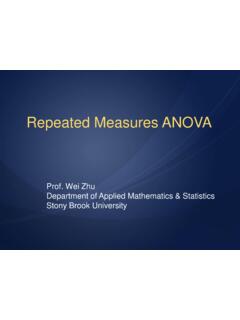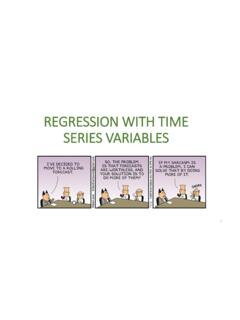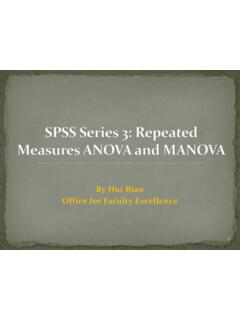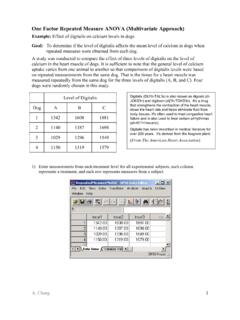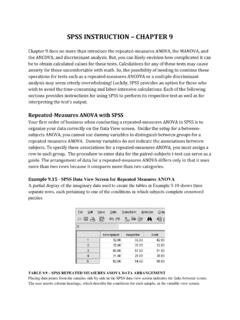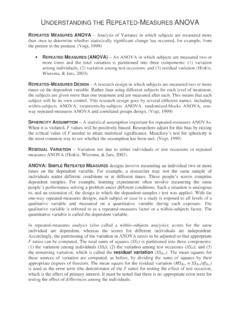Transcription of AMS577. Repeated Measures ANOVA: The …
1 1 ams577 . Repeated Measures anova : The Univariate and the multivariate analysis approaches 1. One-way Repeated Measures anova One-way (one-factor) Repeated - Measures anova is an extension of the matched-pairs t-test to designs with more columns of correlated observations. Assume that the data used in the computing example for between-subjects anova represented performance scores of the same 4 respondents under three different task conditions: Task 1 Task 2 Task 3 Mean P1 3 5 2 P2 4 5 3 P3 5 7 5 P4 6 7 6 Mean In an analysis of Task effects, any variance between subjects (variation in the right-hand column) is not of interest. This variance simply reflects that participants differ overall ( P1 seems to perform less well than P4), but is independent of effects of the different task conditions on people s performance.
2 Between-subjects variance thus is removed before the effects of the Repeated - Measures factor are tested. This could be achieved by subtracting each score from that person s mean score across the three tasks, yielding:Between-subjects variance thus is removed before the effects of the Repeated - Measures factor are tested. This could be achieved by subtracting each score from that person s mean score across the three tasks, yielding: Task 1 Task 2 Task 3 Mean P1 0 P2 0 P3 0 P4 0 Mean 0 2 These new scores do not reflect differences between subjects any more, whereas the differences between task conditions are still reflected in the column means. The anova for Repeated measurements achieves this by first partitioning the sums of squares into a between-subjects component ( variation between the row means of the first table) and a within-subjects component (all remaining variation).
3 The within-subjects component is further subdivided in variation between treatments ( between the column means in the second table) and error variation ( within the columns of the second table). [The between-subjects component can also be further subdivided if there are between-subjects factors to be considered; but this will not concern us for the moment.] The degrees of freedom are divided into the same components: dftotal = k n 1 dfbetween-ss = n 1 dfwithin-ss = n (k 1) dfbetween-treatments = k 1 dferror = (n 1) (k 1) Mean squares are derived as usual by dividing sums of squares with their associated df. SStotal SSbetween-subjects SSwithin-subjects SSbetween-treatments SSerror 3 The F-ratio of MSbetween-treatments and MSerror thus derived is used to test the effect of the within-subjects factor against the null hypo-thesis that all pairwise differences between treatments are zero.
4 Note that both MSerror and MSbetween-treatments in this model may contain variation that is due to a treatment x subjects interaction, which itself is not testable (why?). So the fact that different people may react differently to various treatments cannot be separated from chance variations or treatment main effects. The test of treatment effects is not affected by this problem because the potential interaction term is hidden in both the numerator and the denominator of the F-ratio. This would not be the case for a test of the between-subjects effect (for which a conservative bias would be introduced if an interaction were in fact present). But note that we would not normally test the between-subjects variation for significance in this kind of design.
5 (If significant, it would only tell us that people are different - and didn t we know this all along?) 4 Example: Suppose there are k regions of interest (ROI s) and n subjects. Each subject was scanned on baseline (soda) as well as after drinking alcohol. Our main hypothesis is whether the change between baseline and alcohol is homogeneous among the ROI s. That is 012:kH , where j is the effect of alcohol on the jth ROI,1, , .jk Profile Plots Illustrating the Questions of InterestTest for Equal Changes in Different ROIs(That is, whether the two series are parallel.)AlcoholBaselineBrain Regions of Interest (ROI) Functional Level1 Figure 1. Hypothesis in terms of the original data Profile Plots Illustrating the Questions of InterestTest for Equal Changes in Different ROIs(That is, whether the two series are parallel.)
6 Brain Regions of Interest (ROI) in Brain Functional Level1 Difference Figure 2. Hypothesis in terms of the paired differences 5 The Univariate analysis Approach For subject i, let Yij denote the paired difference between baseline and alcohol for the jth ROI, then the (univariate) Repeated Measures anova model is: ijjiijYS , where j is the (fixed) effect of ROI j,iS is the (random) effect of subject i,ij is the random error independent of iS. With normality assumptions, we have: , and are independent to each other. Let '12, , ,iiiikYY YY , we have , 1, ,in , where '12, , ,k and 2222222222222111sssssssss with 222ss and 222s . This particular structure of the variance covariance matrix is called compound symmetry.
7 For each subject, it assumes that the variances of the k ROI s are equal 2 and the correlation between each ROI pair is constant , which may not be realistic. The univariate approach to one-way Repeated Measures anova is equivalent to a two-way mixed effect anova for a randomized block design with subject as the blocks and ROI s as the treatments . The degrees of freedom for the anova F-test of equal treatment effect is 1k and 11nk respectively. That is, . We will reject the null hypothesis at the significance level if 01,11knkFF . 6 The multivariate analysis Approach Alternatively, we can use the multivariate approach where no structure, other than the usual symmetry and non-negative definite properties, is imposed on the variance covariance matrix in , 1, ,in.
8 Certainly we have more parameters In this model than the univariate Repeated Measures anova model. The test statistic is '12'01Tn nCYCQCCY where 1niiYY , '1niiiQY Y Y Y , and 1 1 00 00 1 10 00 0 01 1C . Under the null hypothesis, . Recall that if , then Therefore the Hotelling s 21, 1knT statistic has the following relationship with the F statistics: We will reject the null hypothesis at the significance level if 01,1kn kFF (upper tail percentile). When to use what approach? There are more parameters to be estimated in the multivariate approach than in the univariate approach.
9 Thus, if the assumption for univariate analysis is satisfied, one should use the univariate approach because it is more powerful. Huynh and Feldt (1970) give a weaker requirement for the validity of the univariate anova F-test. It is referred to as the Type H Condition . A test for this condition is called the Machly s Sphericity Test. In SAS, this test is requested by the PrintE option in the Repeated statement. 7 Example 1. One-way Repeated Measures anova (n=4, k=4), Paired Differences in Brain Functional Levels Subject ROI 1 ROI 2 ROI 3 ROI 4 1 5 9 6 11 2 7 12 8 9 3 11 12 10 14 4 3 8 5 8 SAS Program: One-way Repeated Measures analysis of Variance data repeatM; input ROI1-ROI4; datalines; 5 9 6 11 7 12 8 9 11 12 10 14 3 8 5 8 ; proc anova data=repeatM; title 'one-way Repeated Measures anova '; model ROI1-ROI4 = /nouni; Repeated ROI 4 (1 2 3 4)/printe; run; (Note: SAS Proc GLM and Proc Mixed can also be used for the Repeated Measures anova /MANOVA analyses.)
10 8 SAS Output: One-way Repeated Measures analysis of Variance 1. Estimated Error Variance-Covariance Matrix ROI_1 ROI_2 ROI_3 ROI_1 ROI_2 ROI_3 2. Test for Type H Condition --- Mauchly's Sphericity Tests (Note: p-value for the test is big, so we can use the univariate approach) Variables DF Criterion Chi-Square Pr > ChiSq Orthogonal Components 5 3.
